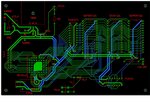hallo99
Newbie level 6
Hello,
could someone tell me if there is a EMI problem to expect with this 8051 circuit layout ?
It runs at 6MHz clock and the buses should run at 500kHz.
I messed the placing of the decoupling capacitor at the 8051 cpu, i think it should have been above the CPU and connected via a top layer strip to GND under the CPU. At its current position it may form a loop area.
My fear is that this circuit could interfere with my neighbours consumer electronics or DCF clocks for example.
Could you please help me with this ?
could someone tell me if there is a EMI problem to expect with this 8051 circuit layout ?
It runs at 6MHz clock and the buses should run at 500kHz.
I messed the placing of the decoupling capacitor at the 8051 cpu, i think it should have been above the CPU and connected via a top layer strip to GND under the CPU. At its current position it may form a loop area.
My fear is that this circuit could interfere with my neighbours consumer electronics or DCF clocks for example.
Could you please help me with this ?
